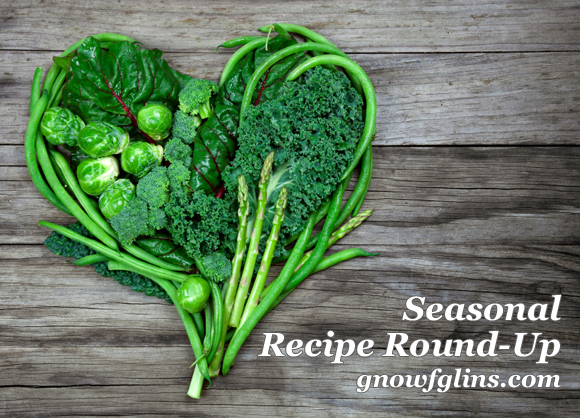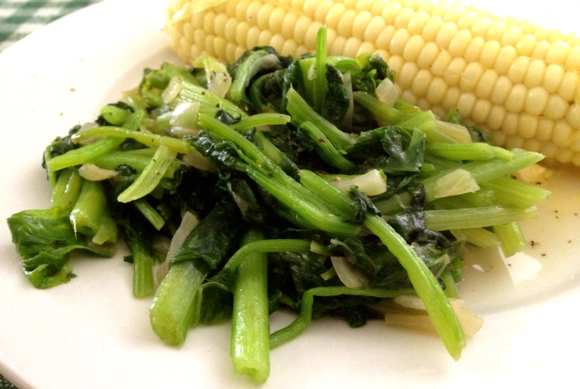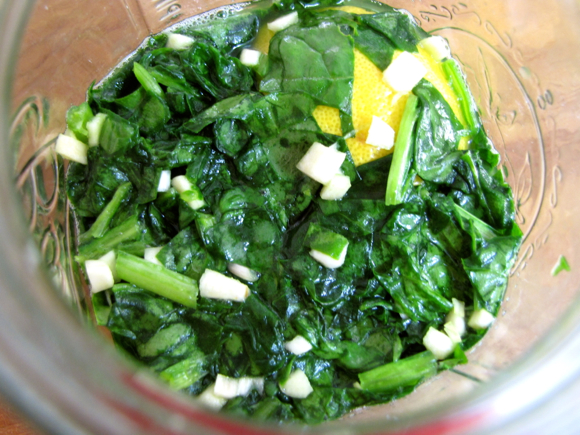
Welcome to our second Seasonal Recipe Round-Up! This time we’re featuring spinach (and next time is rhubarb). I’m sharing my tips and a favorite recipe, and you can participate by sharing your own tips and/or recipes in the comments.
What is Spinach?
Spinach is a dark leafy green (like chard, kale, beet greens, collard greens, mustard greens). There are many varieties of spinach, categorized by leaf type. Savoy has curly, springy leaves. Then you’ve got flat-leaf spinach, and finally baby spinach. I find the flavor earthy and a little sweet. Definitely mild.
Though spinach can be grown year-round in the right conditions (not too hot, not too cold), its seasons are really March through May and September through October. Our property is cool (north-facing) and we’re just getting our gardens in — one of the first things I’ll plant will be spinach.
The Good and the Bad
Spinach one of the more nutritious vegetables, being high in vitamins and minerals, especially Vitamin C. However, it also (like other dark leafy greens) contains an anti-nutrient called oxalic acid. Oxalic acid binds with minerals in the digestive tract just as phytic acid does. To reduce oxalic acid, you should steam or ferment dark leafy greens. The recipe I’m sharing today is a fermented spinach recipe — spinach kraut. For more fermented green recipes, see my online class in lacto-fermentation or my book The Complete Idiot’s Guide to Fermenting Foods.
How to Steam Spinach
Steam for just long enough to wilt the spinach (about a minute), but keep it brightly colored — this reduces oxalic acid yet preserves other nutrition. You can use a steamer basket, or you can put the spinach right in a few inches of simmering water in a pot.
Once steamed, drain the cooking water and discard it; it contains oxalic acid plus other impurities (like pesticides or nitrites if the produce was conventional). Then toss with additional ingredients or add to soups or dishes. For an example of this technique, see my Feta and Chard recipe.
You might run into recipes that call for an addition of greens to be cooked right along with everything else. This keeps the oxalic acid in the dish. Instead, steam the greens separately and add them to the dish after draining.
My Mom’s Lemon Spinach
This is my mom’s delicious and simple steamed spinach dish, and we made it just this week during her visit. We saute onions and garlic in butter while steaming the spinach separately. Then we toss them together, season with salt, and drizzle with lemon juice.

What About Green Smoothies?
It is best to add raw greens like spinach sparingly, rather than regularly. As an alternative, consider steaming the spinach, then adding it to the smoothie after it is cooled. If you have an abundance of spinach, steam it then freeze or dehydrate it to add to smoothies over time.
How to Store and Use Spinach
Store unwashed leaves in plastic bags in your refrigerator (preferably a crisper drawer) for 2 to 3 days, or up to a week. To use, wash and dry leaves. Trim off ends and any bad spots. Then use in recipes.
My Recipe: Spinach Kraut
In today’s Seasonal Recipe Round-Up, I’m sharing a fresh and lemon take on kraut — Spinach Kraut. We love to take this on picnics or serve alongside cold meats, cheese, crackers — or any kind of eggs! 🙂
Click here to see my recipe for Spinach Kraut.
Now, it is your turn to share!
How to Participate in the Seasonal Recipe Round-Up
Bloggers and non-bloggers, feel free to add a comment here with your favorite recipes or posts.
Please use real, whole ingredients in recipes, and preferably traditional methods of preparation. Whole ingredients means whole grains, vegetables, legumes, meats, and unrefined sweeteners. In order to keep the integrity of “nourishing” food, I will delete any recipes that use processed, boxed foods. Where possible, incorporate traditional methods of preparation, like soaking, sprouting and fermenting. The idea here is that your recipes and tips should help our readers find traditional methods for preparing seasonal vegetables.
Share Your Spinach Recipes and Tips!
Other Seasonal Recipe Round-Ups:
All seasonal recipe round-ups are listed on the Recipes page.
...without giving up the foods you love or spending all day in the kitchen!

2 free books:
Eat God's Way
Ditch the Standard American Diet, get healthier & happier, and save money on groceries...
We only recommend products and services we wholeheartedly endorse. This post may contain special links through which we earn a small commission if you make a purchase (though your price is the same).



Hi Wardee, I’m sharing my Chicken and Spinach breakfast sausage, and Split Pea and Spinach soup. Now I’ll have to start thinking about rhubarb recipes!
I need to start thinking about rhubarb recipes, too. 😉
Thanks for linking up — both dishes look delish!
Hi Wardee,
Thanks for these great greens recipes. I love all of them and can’t wait until my spinach, kale, chard all start growing. They just peaked their little heads above ground today. Now if I can fight off the quail, I’ll have me some good greens–yummmm.
A question: Have you ever “cultured” hard boiled eggs like we culture carrots and other veggies? The hens are a-laying right now and I have an abundance of eggs.
Hi Marley! Obviously, I’m not Wardee, but wanted to let you know that Lesson 16 of her lacto-fermentation course covers pickling eggs, and I believe her new book does too.
A friend just sent me home with 18 eggs, so I think I’d better start pickling them too!
Marly — Holly is right. 🙂
Basically the idea is you take hard-boiled eggs and stuff them in a jar covered with brine. The brine could be beet kvass, juice from fermenting beets, sauerkraut juice, a fresh brine (1/2 cup salt to 1/2 gallon water). You can add any garnishes you’d like, like fresh dill, sliced onions, peppercorns… The sky is the limit. My class materials and the new book both contain sample recipes.
Wardee, I’ve done beet kvass and dill pickles with the ferment method. I just didn’t know if it was safe to do it with hard boiled eggs because they are so dense. Thanks so much.
Thanks, Holly. I appreciate your feedback. I’ll look into this.
Great information on spinach, thank you!
I am looking forward to the Rhubarb round-up as I believe the rhubarb in our garden will be ready to harvest shortly. It is from the previous owners, but we had to rescue it from neglect due to the house being empty for some years. The neighbors all say it was delicious though, so I’m excited to try it!
Hi! I just found your blog… someone (Holly!) left me a comment on my site saying that I should link up my milkshake recipe where I used spinach instead of food coloring. I hope it meets the criteria for real, whole foods. I used store-bought SO Delicious ice cream but their ingredient list is great… no dairy, sugar, or artificial anything! Thanks for the great round-up!
Cassidy
Where do you buy your olive oil?
Hi and thanks for hosting!
This week I’m sharing my recipe for Saag Paneer (Indian Creamed Spinach), an exotic treat and a soothing, simple comfort food.
Have a great weekend!
Hi Wardee! Thanks for sharing this recipe to us! 🙂 You said spinach is a good source of vitamin C. But do you happen to know if it is also rich in vitamin K2?